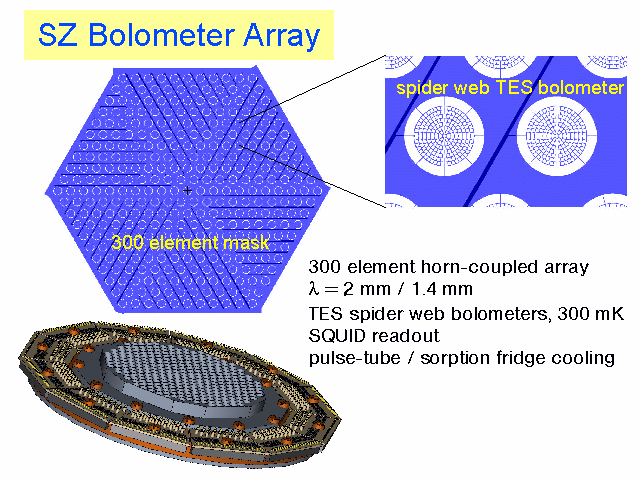






Notes:
The receiver will consist of a 300 element hexagonal close-packed bolometer array, fed by an array of smooth-walled conical horns with 2 f l aperture diameter. We will use a single bolometer array for both frequencies of interest, and will swap between two horn arrays to control frequency sensitivity. The bolometers will be Si3N4 "spiderweb" Transition Edge Sensor (TES) bolometers, with quarter-wavelength backshort reflectors to maximize absorption of incident radiation. These detector arrays are being fabricated at the Berkeley Microlab on segments of silicon wafers. The TES devices are low impedance devices that are less susceptible to microphonics than doped semiconductor bolometers. Fabrication of the TES devices by conventional optical photolithography and the development of SQUID multiplexers (which the Berkeley group is currently working on) will allow the development of large arrays.
The horn and bolometer arrays must be cooled to 300 mK for optimum operation of the TES bolometers. A pulse-tube cooler will be used to reach the 4 Kelvin operating point of the three-stage sorption refrigerator. The pulse-tube cooler has the advantage of not requiring liquid cryogens, reducing logistical and personnel demands.
All back-end electronics and data acquisition systems for the SZ receiver are also being developed by the Berkeley group. The TES bolometers are operated with voltage-bias, so the signal will be read out as a current measured by a shunt-feedback SQUID amplifier, with one SQUID per sensor. SQUID's are ideally matched to our sensors, as their low input impedance helps to maintain the constant voltage bias of the bolometers. Shunt feedback to the SQUID input coil improves the dynamic range of the readout and facilitates ac-bias operation. The Berkeley group is also currently working on a frequency domain SQUID multiplexer to read out large arrays of detectors, and this technology may appear in future generations of the APEX SZ receiver.












